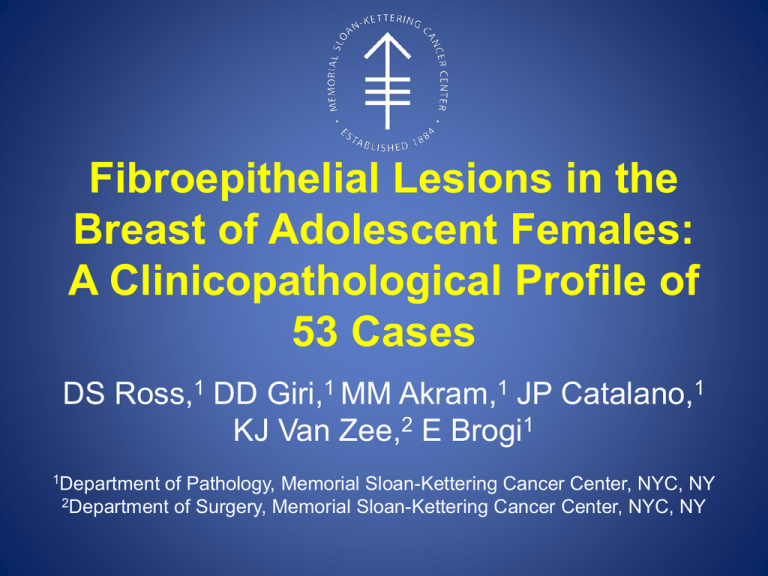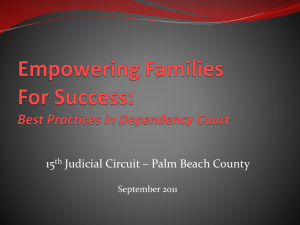
Fibroepithelial Lesions in the
Breast of Adolescent Females:
A Clinicopathological Profile of
53 Cases
DS Ross,1 DD Giri,1 MM Akram,1 JP Catalano,1
KJ Van Zee,2 E Brogi1
1Department
of Pathology, Memorial Sloan-Kettering Cancer Center, NYC, NY
2Department of Surgery, Memorial Sloan-Kettering Cancer Center, NYC, NY
Background
Fibroepithelial lesions (FELs):
• Most common breast abnormality in
adolescent females (< 18 years-old)
• Referred to as:
-
Fetal fibroadenoma
Cellular fibroadenoma
Juvenile fibroadenoma
Giant fibroadenoma
Fibroadenoma variant
-
Tubular adenoma
Hamartoma
Cystosarcoma phyllodes
Phyllodes tumor
Study Aims
• Investigate the morphology and clinical
behavior of FELs in adolescents
• Standardize the diagnostic terms used for
FELs in adolescents based upon histologic
criteria
Study Design (1)
• Search of MSKCC pathology database
– Age < 18 years-old
– Excision or mastectomy between 19922011
– Diagnosis of any fibroepithelial lesion
• 7 FELs from a prior series were also
included (1975-1983)
Barrio AV et al. Ann Surg Oncol 2007
Study Design (2)
• 3 pathologists reviewed all available slides
• Features noted:
• Gross & microscopic size
• Borders / margin status
• Growth pattern
• Stromal overgrowth
• Stromal cellularity
• Nuclear pleomorphism
• Epithelial hyperplasia
• Stromal cell mitoses
• Smooth muscle actin-α (1A4, DAKO)
staining performed on available tissue
Study Design (3)
• Patient information and clinical follow-up
obtained from e-medical records
– Age at presentation
– Age at menarche
– Race
– Laterality
– Family history
Patient Population (1)
FELs
N=53
Patients
N=47 F
Solitary FEL
42
Multiple FEL
5
3 ipsilateral
1
2 ipsilateral
2
bilateral
2
Race
N=23
White
16
AfricanAmerican
7
Patient Population (1)
FELs
N=53
Patients
N=47 F
Solitary FEL
42
Multiple FEL
5
3 ipsilateral
1
2 ipsilateral
2
bilateral
2
Race
N=23
White
16
AfricanAmerican
7
Age (years)
Mean Age at Diagnosis
15.4 (10-18)
Mean Age for Menarche*
- Median time from Menarche to Dx**
12.0 (10-14)
48 mo
*Information available for 26 patients
**1 patient presented 12 mo prior to menarche
Patient Population (2)
Laterality
N=53
Right
33
Left
20
Presentation of FEL
N = 42
Palpable Mass
41
Ultrasound
1*
Patients
Family History of Breast CA
13
*Pt undergoing US for ipsilateral FEL
53 Fibroepithelial Lesions
Low Grade
Malignant
Phyllodes Tumor
2%, N=1
Benign
Phyllodes Tumor
28%, N=15
Malignant
Phyllodes Tumor
6%, N=3
Usual
Fibroadenoma
21%, N=11
Juvenile
Fibroadenoma
43%, N=23
Malignant Phyllodes Tumor (8%),
Low Grade N=1,High Grade N=3
• Gross size*: 4 & 25cm
• Infiltrative borders**
• Stromal overgrowth
– All high grade tumors
*Gross size available for 2 cases
**Borders assessable in 2 case
Malignant Phyllodes Tumor (8%),
Low Grade N=1,High Grade N=3
• Increased stromal
cellularity
• Moderate-marked stromal
nuclear atypia
• Mean mitotic count / 10
HPF:
– Low grade: 10
– High grade: 17 (12-20)
Benign Phyllodes Tumor, N=15 (28%)
• Mean gross size*: 4 cm (1-13
cm)
• Borders**:
– Circumscribed: 11/14 (79%)
– Infiltrative: 3/14 (21%)
• Stromal overgrowth: 13%
(2/15)
• Growth pattern
– Intracanalicular: 10/15 (67%)
– Pericanalicular: 5/15 (33%)
*Gross size available for 11 cases
**Borders assessable in 14 cases
Benign Phyllodes Tumor, N=15 (28%)
• Increased stromal
cellularity
• Mild-moderate stromal
nuclear atypia
• Epithelial hyperplasia: 7/15
(47%)
• Mean mitotic count / 10
HPF: 3.1 (1-7)
Benign Phyllodes Tumor, N=15 (28%)
• Increased stromal
cellularity
• Mild-moderate stromal
nuclear atypia
• Epithelial hyperplasia: 7/15
(47%)
• Mean mitotic count / 10
HPF: 3.1 (1-7)
Benign Phyllodes Tumor, N=15 (28%)
• Increased stromal
cellularity
• Mild-moderate stromal
nuclear atypia
• Epithelial hyperplasia: 7/15
(47%)
• Mean mitotic count / 10
HPF: 3.1 (1-7)
Usual Fibroadenoma, N=11 (21%)
• Mean gross size: 2.6 cm
(0.7-4.5 cm)
• Circumscribed borders
• Growth pattern
– Intracanalicular: 10/11 (91%)
– Pericanalicular: 1/11 (9%)
Usual Fibroadenoma, N=11 (21%)
• Increased stromal cellularity:
3/11 (27%)
• No stromal nuclear atypia
• Epithelial hyperplasia: 2/11
(18%)
• Mean mitotic count / 10 HPF:
1.3 (0-6)
– 6 mit / 10 HPF in pt pregnant 1y before;
FA w/ focal lactational changes
– Mean mitotic count w/o above pt is 0.8
Usual Fibroadenoma, N=11 (21%)
• Increased stromal cellularity:
3/11 (27%)
• No stromal nuclear atypia
• Epithelial hyperplasia: 2/11
(18%)
• Mean mitotic count / 10 HPF:
1.3 (0-6)
– 6 mit / 10 HPF in pt pregnant 1y before;
FA w/ focal lactational changes
– Mean mitotic count w/o above pt is 0.8
Usual Fibroadenoma, N=11 (21%)
• Increased stromal cellularity:
3/11 (27%)
• No stromal nuclear atypia
• Epithelial hyperplasia: 2/11
(18%)
• Mean mitotic count / 10 HPF:
1.3 (0-6)
– 6 mit / 10 HPF in pt pregnant 1y before;
FA w/ focal lactational changes
– Mean mitotic count w/o above pt is 0.8
Juvenile Fibroadenoma, N=23 (43%)
• Mean gross size*: 3.1 cm
(0.5-7 cm)
• Circumscribed borders
• Growth pattern
– Pericanalicular
– Floridly glandular
– Retention of lobular structure
*Gross size available for 22 cases
Juvenile Fibroadenoma, N=23 (43%)
• Increased stromal
cellularity: 14/23 (61%)
• No stromal nuclear atypia
• Epithelial hyperplasia:
7/23 (30%)
• Mean mitotic count / 10
HPF: 1.8 (0-7)
Juvenile Fibroadenoma, N=23 (43%)
• Increased stromal
cellularity: 14/23 (61%)
• No stromal nuclear atypia
• Epithelial hyperplasia:
7/23 (30%)
• Mean mitotic count / 10
HPF: 1.8 (0-7)
Juvenile Fibroadenoma, N=23 (43%)
• Increased stromal
cellularity: 14/23 (61%)
• No stromal nuclear atypia
• Epithelial hyperplasia:
7/23 (30%)
• Mean mitotic count / 10
HPF: 1.8 (0-7)
Juvenile Fibroadenoma, N=23 (43%)
SMAα
Juvenile Fibroadenoma
• A distinctive type of FA
– Collagenized and cellular stroma
– Pericanalicular growth pattern
– Lobular arrangement
– +/- Florid ductal hyperplasia
Juvenile Fibroadenoma:
Variation in Morphology
Fibroadenoma Variant
Azzopardi, 1979
• Characterized by
collagenous and cellular
stroma
• “…related to FAs in
structure and
composition but show
sufficient difference to
raise problems in precise
dx and classification”
– Differential dx often
includes a phyllodes
tumor
Juvenile Fibroadenoma,
Variant Pattern (N=8/23)
Problems in Breast Pathology, Azzopardi, 1979
Case from our series
Juvenile Fibroadenoma:
Variant Pattern & Intratumoral Heterogeneity (N=4/23)
Juvenile Fibroadenoma:
Variant Pattern & Intratumoral Heterogeneity (N=4/23)
Distinguishing Features
Juvenile Fibroadenoma
Benign Phyllodes Tumor
Distinguishing Features
Juvenile Fibroadenoma
Benign Phyllodes Tumor
Distinguishing Features
Juvenile Fibroadenoma
Benign Phyllodes Tumor
Mean Mitotic Count: 1.8 (0-7)
Mean Mitotic Count: 3.1 (1-7)
Original Diagnosis
25
Original
20
14
13
N
15
10
5
8
10
2
1
0
FEL
3
1
1
Reclassification
25
23
Original
20
N
15
10
14
13
11
10
8
5
0
Reclassified
15
0
2
1 1
0
FEL
3 3
1 0
1 0
Follow-Up
• 37 patients (41 FELs)
– Mean follow-up: 40 months
• From less than a month to 278 months
2 Recurrent Cases
• Information for index FEL
BPT
LGMPT
Months
to Recur.
Gross
Size
(cm)
Borders
Increased
Stromal
Cellularity
Mitotic
count
per 10
HPF
Stromal
atypia
12.2
8.5
Infiltrative
Yes
4
Mild
18
N/A
Infiltrative
Yes
10
Moderate
1992-2011: 46 Consecutive
Fibroepithelial Lesions
Malignant
Phyllodes Tumor
4%, N=2
Benign
Phyllodes Tumor
26%, N=12
Juvenile
Fibroadenoma
46%, N=21
Usual
Fibroadenoma
24%, N=11
Conclusions
• FEL in adolescents
– Benign in two-thirds of cases
• Juvenile FA 46%, Usual FA 24%
Conclusions
• FEL in adolescents
– Benign in two-thirds of cases
• Juvenile FA 46%, Usual FA 24%
– Frequent stromal mitoses
Conclusions
• FEL in adolescents
– Benign in two-thirds of cases
• Juvenile FA 46%, Usual FA 24%
– Frequent stromal mitoses
• Juvenile FA is the most common FEL
– Distinctive morphology
Conclusions
• FEL in adolescents
– Benign in two-thirds of cases
• Juvenile FA 46%, Usual FA 24%
– Frequent stromal mitoses
• Juvenile FA is the most common FEL
– Distinctive morphology
– +/- Stromal expansion and intratumoral
heterogeneity (fibroadenoma variant)
References
1.
2.
3.
4.
5.
6.
7.
8.
9.
10.
11.
12.
Amerson, J.R., Cystosarcoma phyllodes in adolescent females. A report of seven
patients. Ann Surg, 1970. 171(6): p. 849-56.
Ashikari, R., J.H. Farrow, and J. O'Hara, Fibroadenomas in the breast of juveniles. Surg
Gynecol Obstet, 1971. 132(2): p. 259-62.
Azzopardi, J.G., A. Ahmed, and R.R. Millis, Problems in breast pathology. Major
problems in pathology1979, Phildelphia: Saunders. xvi, 466 p.
Barrio, A.V., et al., Clinicopathologic features and long-term outcomes of 293 phyllodes
tumors of the breast. Ann Surg Oncol, 2007. 14(10): p. 2961-70.
Ewing, J., Neoplastic Diseases, 2nd ed.1927, Philidelphia: W. B. Saunders.
Hertel, B.F., C. Zaloudek, and R.L. Kempson, Breast adenomas. Cancer, 1976. 37(6): p.
2891-905.
Koerner, F.C.. Diagnostic Problems in Breast Pathology. 2009, Philadelphia: Saunders.
Mies, C. and P.P. Rosen, Juvenile fibroadenoma with atypical epithelial hyperplasia. Am J
Surg Pathol, 1987. 11(3): p. 184-90.
Pike, A.M. and H.A. Oberman, Juvenile (cellular) adenofibromas. A clinicopathologic
study. Am J Surg Pathol, 1985. 9(10): p. 730-6.
Rosen, P.P., Rosen's breast pathology. 3rd ed 2008, Philadelphia: Lippincott Williams &
Wilkins.
Tavassoli, F.A., Pathology of the breast. 2nd ed1999, Stamford, Conn.: Appleton &
Lange. xi, 874
Wulsin, J.H., Large breast tumors in adolescent females. Ann Surg, 1960. 152: p. 151-9.










